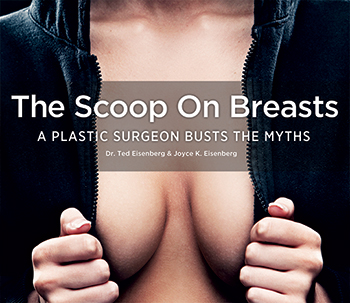Cosmetic Breast Surgery: Lessons Learned From 56,000 Breasts
I’ve examined a lot of breasts – at least 56,000 – during my career as a plastic surgeon. How’d I get to that number? About 7,000 women have come to me for breast augmentation and breast lift surgery. On average, I see each woman about four times – once before her surgery and three times afterward for post-op visits.
So, 7,000 women x 2 breasts x 4 visits = 56,000. That’s not a problem that would have been on your sixth-grade math homework.
Through the years, I’ve observed every variation in breast size and shape, in breast perkiness and nipple size, and in women’s thoughts about their figure and their cosmetic surgery goals.
If I could sum up what I’ve discovered in one sentence, it would be this: You shouldn’t make assumptions about who gets breast augmentation – and why.
Don’t assume that . . .
. . . many of my patients are exotic dancers. Only about 1 percent of my patients are exotic dancers. The other 99 percent include teachers, nurses, hairstylists, construction workers, doctors, ballroom dancers, stay-at-home moms, company executives, waitresses, fitness trainers, bartenders, cheerleaders, policewomen who want to know how soon they can put their bulletproof vests back on, and women in all branches of the military who email us from Iraq and Afghanistan to set up appointments for when they are back in the United States. This is not a complete list of breast surgery patients.
. . . breast implants are just for younger women. True, the large number  of breast augmentation patients are in their 20s, women who come in because they want to feel more feminine and self-confident. “It’s pretty bad when your 13-year-old sister can already wear your bra,” one woman told me.
of breast augmentation patients are in their 20s, women who come in because they want to feel more feminine and self-confident. “It’s pretty bad when your 13-year-old sister can already wear your bra,” one woman told me.
The second largest demographic is in their 30s. Many women in this age range come in because they liked the fullness of their breasts during pregnancy and want to recapture that look. Others have lost weight and with it their breast volume.
Women 40 and older – and even in their 60s – come in for breast augmentation surgery, too. They want to look as good on the outside as they feel on the inside. They tell me they’ve been taking care of everyone else for years and now they’re ready to do something for themselves. Many have been thinking about breast augmentation for years.
Likewise, my breast augmentation patients are women are all ages. While many come in after they’ve had children or a significant change in weight, others are young women who developed that way.
. . . women get cosmetic breast surgery to attract attention. “Do you want to be proportional, turn heads or stop traffic?” That’s what one of my colleagues asks a prospective breast augmentation patient to see what she has in mind. I’ve tried it. Most women tell me they want their figure to be more proportional, and they want to fit better in their sweaters, bikinis and tank tops. Some comment that they wouldn’t mind turning heads now and then. Not many want to stop traffic. Ironically, some of my patients are policewomen who literally stop traffic – but they would rather not do it with their breasts. [WATCH OUR VIDEO: Breast Implants: Do They Look Fake?]
. . . women get breast implants to make men happy. Only two women out of 6,000 have ever told me that their partner wants them to get implants. Instead, women have consistently told me that their partners love them exactly the way they are, and they are having surgery to make themselves look and feel better. So, sorry guys. Women don’t get implants to please you. That might be an outcome, but it’s not the motivation.
. . . a woman’s breasts are the same on the right and left side. Breasts are sisters, not twins. Few women have identical breasts; the difference might be slight or more obvious. Nipple position, chest diameter, the amount of breast tissue, the location of the breast on the chest wall, and how high or low a breast hangs all contribute to the appearance. With all these variables, it is no surprise that no one has identical twins. [WATCH OUR VIDEO: Correcting Breast Asymmetry]
. . . women need much guidance from me. Women know what they want. During medical training, we are taught that we should know the answers, that we are the authority. But I have discovered that women know best. My job is to listen carefully and to determine if there is a match between their goals and what I can accomplish. I believe I am an expert at figuring that out.





 CLICK HERE TO BUY
CLICK HERE TO BUY







